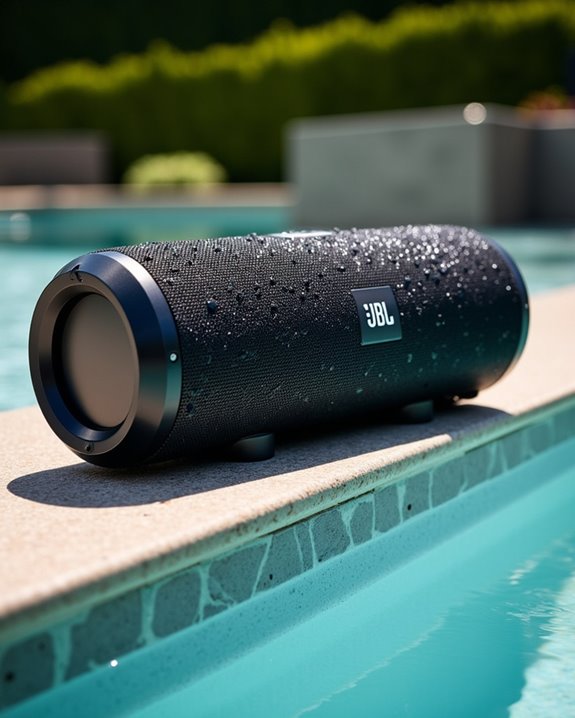For ideal sound quality, 16-gauge (AWG) speaker wire suffices in most home audio setups with runs under 50 feet and 8-ohm speakers. Longer distances or lower impedance speakers (4 ohms) require 14-gauge or 12-gauge wire to maintain signal integrity. High-power amplifiers exceeding 150W RMS need thicker 14-gauge or better wire for efficient power delivery. Pure copper conductors outperform copper-clad aluminum alternatives. Understanding additional factors like environmental conditions and installation requirements guarantees maximum system performance.
Key Takeaways
- 16 AWG speaker wire provides the optimal balance of cost and performance for most home audio setups under 50 feet.
- For runs over 50 feet or low impedance speakers (2-4 ohms), use 12-14 AWG wire to maintain signal quality.
- High-power amplifiers above 150W RMS require 14 AWG or thicker wire for efficient power transfer.
- Match 8-ohm speakers with 16-18 AWG wire and 4-ohm speakers with 12-14 AWG wire for best results.
- Pure copper wire offers better conductivity than copper-clad aluminum and should be preferred for optimal sound quality.
Understanding Speaker Wire Gauge Basics
The selection of appropriate speaker wire gauge represents a fundamental consideration in audio system design, with the American Wire Gauge (AWG) system serving as the standardized measurement since 1857. This established system assigns lower numbers to thicker conductors, with common speaker wire gauges ranging from 12AWG to 18AWG.
Wire materials and construction methods greatly influence performance, with oxygen-free copper (OFC) offering superior conductivity compared to copper-clad aluminum alternatives. While originally developed for solid-core electrical applications, modern speaker cables typically utilize stranded construction, providing enhanced flexibility without compromising signal integrity. The gauge history reveals an evolution from basic electrical conductors to specialized audio cables, though the fundamental principles of electrical conductivity remain constant. Standard 16AWG wire has emerged as the ideal choice for most home audio applications, effectively balancing cost, performance, and practicality.
How Cable Length Affects Your Choice
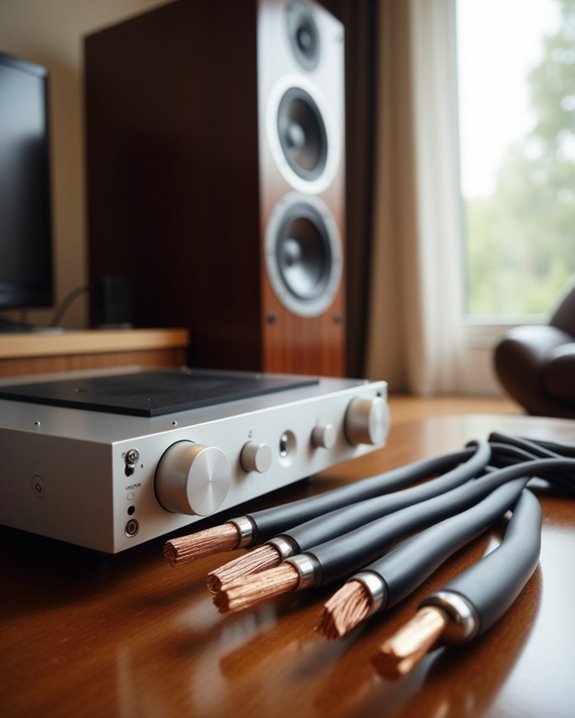
Building upon fundamental gauge selection principles, cable length introduces additional variables that greatly impact speaker wire performance and sound quality. As cables extend beyond 50 feet, resistance increases substantially, requiring compensation through lower gauge selections like 12-14 AWG for ideal signal transmission.
Length symmetry between speaker pairs becomes essential, as uneven cable runs can introduce phase inconsistencies and delay effects in the audio signal. The relationship between length and gauge follows clear technical patterns: 16 AWG suffices for runs under 50 feet with 8-ohm speakers, while longer distances demand 12-14 AWG to maintain frequency response. A 50-foot cable introduces 209 nanoseconds of group delay compared to just 2 nanoseconds in 10-foot runs, though these differences rarely affect typical home listening scenarios.
Matching Wire Gauge to Speaker Impedance
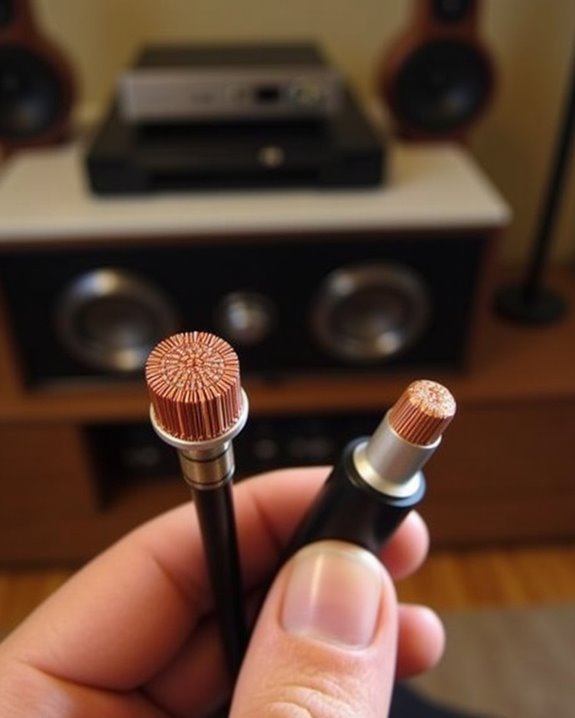
When selecting speaker wire gauge, proper matching to speaker impedance proves essential for maintaining ideal signal transmission and sound quality. The relationship between impedance and wire gauge directly impacts amplifier compatibility and overall system performance. For 4-ohm speakers, 14-gauge or 12-gauge wire provides ideal current flow, while 8-ohm speakers operate efficiently with 16-gauge or 18-gauge wire.
Material selection also plays a vital role, as pure copper wire delivers superior conductivity compared to copper-clad aluminum alternatives. When connecting speakers with lower impedance ratings (2-4 ohms), thicker gauge wire becomes necessary to handle increased current demands. Conversely, higher impedance speakers (6-8 ohms) allow for thinner gauge options while maintaining signal integrity. This systematic approach to matching wire gauge with speaker impedance guarantees ideal performance across various audio setups.
Power Requirements and Wire Selection
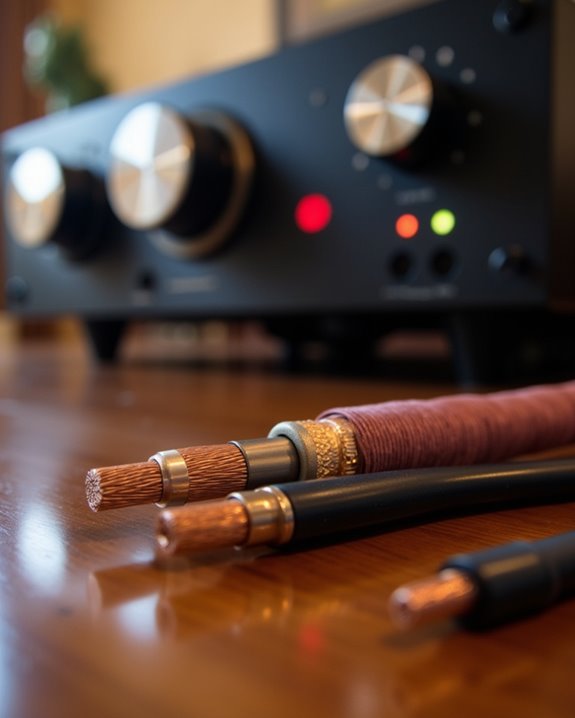
Proper power handling capacity stands as a fundamental consideration when selecting speaker wire gauge for audio systems. The relationship between amplifier pairing and wire gauge directly impacts system performance, with high-wattage amplifiers exceeding 150W RMS requiring 14-gauge or thicker wire for ideal voltage efficiency. This requirement becomes especially critical when driving low-impedance loads.
For typical installations, power requirements follow clear guidelines: 16-gauge wire sufficiently handles up to 125W at 290 feet in 100V systems, while 14-gauge accommodates 60W at 119 feet in 25V systems. The superior voltage efficiency of 100V systems allows for thinner gauge selections over longer distances, exhibiting four times less power loss compared to 25V systems at identical wattages. Understanding these specifications guarantees proper system integration and maintains signal integrity throughout the audio chain.
Common Mistakes When Choosing Speaker Wire
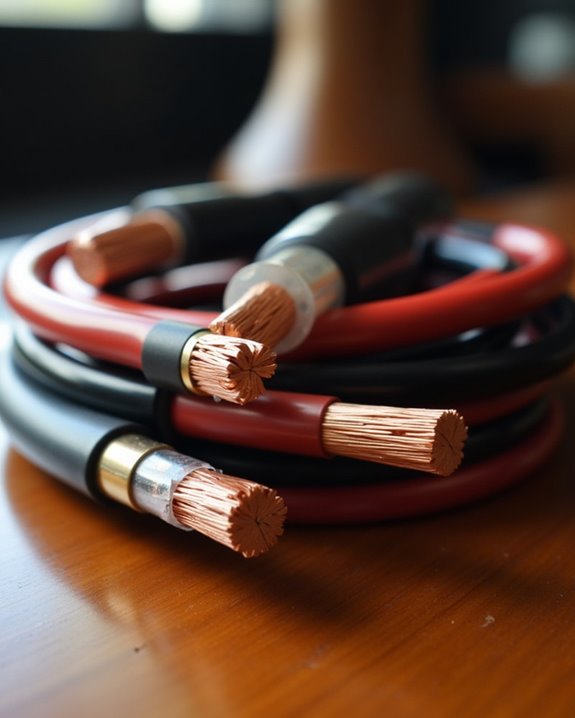
Selecting appropriate speaker wire often leads installers and audio enthusiasts into common pitfalls that can compromise system performance. A critical error involves choosing wire gauge without considering run length, where 18AWG becomes inadequate beyond 32 feet for 8Ω speakers. Aesthetic choices frequently prioritize form over function, with ultra-thin “invisible” wires sacrificing essential conductivity.
Environmental neglect represents another significant oversight, as installers often disregard moisture exposure and physical stress factors. Non-UV-rated cables can deteriorate in outdoor installations, while sharp bends near terminals increase resistance and risk conductor damage. Additionally, many users fall prey to marketing claims about “zero resistance” or “oxygen-free copper,” investing in premium cables that offer negligible performance improvements in typical home audio setups.
Frequently Asked Questions
Can Speaker Wire Gauge Affect Wireless Subwoofer Performance?
Like a hidden link in a chain, wireless subwoofers still depend on proper wire gauge for power delivery and signal integrity. Common gauge myths aside, quality wiring remains essential between components and driver connections.
How Often Should Speaker Cables Be Replaced for Optimal Sound Quality?
Audiophiles typically follow a 10-15 year replacement interval for speaker cables, though quality degradation may necessitate earlier changes. Regular inspections help identify issues like oxidation, fraying, or signal loss that affect performance.
Does Temperature Affect the Recommended Gauge for Outdoor Speaker Installations?
Temperature effects do influence outdoor speaker gauge selection. Higher temperatures cause wire expansion, while colder conditions lead to contraction. Outdoor adaptation typically requires thicker gauges (12-14 AWG) to maintain consistent performance year-round.
Can Mixing Different Gauge Speaker Cables Damage Amplifiers or Speakers?
Mixing different gauge speaker cables won’t damage equipment when minimum requirements are met. While mixed gauges may cause minor signal loss and power loss variations, proper wire thickness selection guarantees safe operation for all audio components.
Should Bi-Wired Speaker Setups Use the Same Gauge for Both Connections?
Like branches of a tree carrying different energies, biwire configurations can effectively utilize varied gauge selections. While matching gauges is common, using different sizes for high and low frequencies remains a valid audiophile choice.




